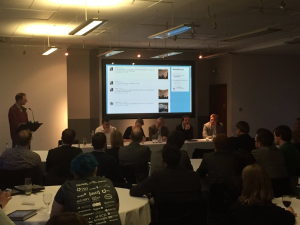Last week government, business and digital experts met in a panel-led discussion on ‘government as a platform’, chaired by subject expert Professor Alan Brown, Co-Director of CoDE . The Surrey Centre for the Digital Economy (CoDE) is a major effort focused on the impact of digital technology on businesses, the economy, and society.
By Guest Blogger Professor Alan Brown
The phrase ‘government as a platform’ was coined in a Tim O’Reilly paper from 2010. Referencing companies such as Wikipedia, Amazon and Google, Tim explained how the new order of disruptive, platform-based organisations integrated their offering with their customers’ behaviour, and fed back data to improve services.
He argued that this should work for government too. Tim criticised the old model of government, where citizens paid their taxes – and received a service, but were otherwise uninvolved: ‘Information produced by and on behalf of citizens is the lifeblood of the economy and the nation; government has a responsibility to treat that information as a national asset.’
How far we have gone towards that goal – and is that goal even appropriate for a government?
To find out, Methods Digital and the Government Digital Service (GDS) hosted a fascinating panel-led discussion at which I acted as Chair. The panel, held at the Royal Institute of British Architects in London, featured Janet Hughes, Programme Director of Gov.uk Verify; Iain Patterson, Director of Common Technology Services at GDS; Dr Mark Thompson, Director at Methods Digital; John Sheridan, Digital Director and Head of Legislation Services at The National Archives; and Michael Wignall, UK National Technology Officer at Microsoft.
Under discussion:
- What exactly does GaaP mean?
- Why might a clear direction on GaaP be a matter of national importance?
- How might a central hub, shared models, and economies of scale be exploited to improve services and drive out waste?
Do we follow the ‘White Rabbit’?
In his paper, Tim described ‘Government as a Platform’ as a white rabbit; in other words, ‘it means whatever we want it to mean’.
The current Cabinet Office description is still ambiguous. It says: ‘Government as a Platform will provide a common set of core systems that enable government departments to share digital services, technology and processes’.
The GDS is steering the transformation. So far, the focus has been mainly on websites, and bringing together information for the user in the portal Gov.uk, which has been very successful in its efforts. But resources are tight, conceptual clarity is lacking, and often organisations are working in isolation and/or confusion on common problems. And ultimately, what happens at the centre, what government itself builds and delivers, is just a small part of the story.
What’s needed is a complete re-design and re-think of the underlying systems that support government, and a way of folding in conversations, suppliers and consumers in a government Marketplace. This Marketplace could foster and deepen understanding, influence policy, highlight present activities, and create the infrastructure for the future. But what does this mean in practice?
In my view, GaaP is made up of three pillars:
- Firstly there are components like Gov.uk and Verify – built in the centre and used for the good of citizens by some or all departments. These should bring cost reduction, whilst increasing ease-of-use, familiarity and trust.
Let’s call this “Platform Engineering”.
- Secondly, commercial platforms, where the basics of a service – such as case management, CRM or finance systems – can be easily procured and integrated, with minimal development.
We can call this “Platform Evangelism”.
- Thirdly, entrepreneurial, bespoke platforms built by communities to deliver something special. These in turn can support wider government efforts, and even contribute to the economy. Just a couple of weeks ago, we saw the launch of just such a product: the new Office of National Statistics publishing platform was built from scratch, and it can now feed data automatically to the rest of government, to citizens, to businesses. It’s O’Reilly’s data dream brought to life.
This we can refer to as “Platform Entrepreneurship”.
These three different approaches to platforms in government – platform engineering, evangelism, and entrepreneurship – must be key tenets of the Government’s approach to GaaP. Defining and executing this strategy is one of the most pressing technology challenges of our day.
So I see Government as a Platform as being part-owned by the centre, without doubt — but also by companies, by enterprising tribes, by citizens.
What is the government’s new role in a digital world? We are shaping it now, and it can only be what we make it. Digitisation of public services needs to be built on the application of open technical standards and a shared set of platform-based architectural principles. Sustainable and meaningful reform and improvement will only be achieved when there is an equal relationship between internal organisational and digital services transformation – driving innovation across the public and private sector, and significantly improving our public services in the digital economy.
Alan W. Brown is Professor of Entrepreneurship and Innovation in the Surrey Business School where he leads activities in the area of corporate entrepreneurship and open innovation models. In addition to teaching activities in
entrepreneurship and global strategy, he focuses on innovation in a number of practical research areas with regard to global enterprise software delivery, agile software supply chains, and the investigation of “open commercial”
software delivery models. For more, please see: A.W. Brown, J. Fishenden, and M. Thompson, “Digitizing Government: Understanding and implementing new digital business models”, Palgrave Macmillan, December 2014.

